The villages, mansions and towns were full of disguises. Dances, tournaments, sleigh rides and masquerades were organized. And most of all, they were eaten - before the fasting started.
The word carnival probably comes from the Italian carnavale - meaning "goodbye to meat". Indeed, this was the point of indulging in the harsh time of Lent, when meat was not eaten and abstinence in eating, drinking and entertainment was cultivated. Therefore before Ash Wednesday came, it was necessary to react before 40 days of moral and culinary asceticism .
The tradition of the post-year indulgence is found throughout medieval Catholic Europe , but scientists see an older pagan provenance of such games and rituals. According to this thesis, the name of the play period comes from carrus navalis - a wagon in the shape of a ship where people danced and played. Such a cart participated in ancient Christmas processions in honor of Dionysus (Bacchus in Rome) or the goddess Isis in Egypt. The popular, fertility-cult play also comes from the Roman Saturnalia celebrated every December.
On the other hand, Italy is considered to be the cradle of the carnival in its masquerade version, of course, Italy, and in particular Venice, where masquerades were organized as early as the 11th century.
Meatball, or great food
In Old Polish times, the period of feasts and games was called Shrovetide and their last, most intense, carnival stage . Shrovetide began with the feast of the Epiphany and lasted until Ash Wednesday, although according to some interpretations the merry celebration did not take place for a week or even only three days before Ash Wednesday. The Old Polish carnival had various scenes, but it is certain that it was grand. The games did not necessarily win the applause of the clergy. In the 16th century, the devastating debauchery among his countrymen was condemned by the Jesuit priest Jakub Wujek:" Meatballs from the devil keep the pinups invented very much" . Calvin Gregory of Żarnowiec, on the other hand, rebuked:" We make more profit to the devil by three days of voracious meat desolation than by fasting for forty days to God."
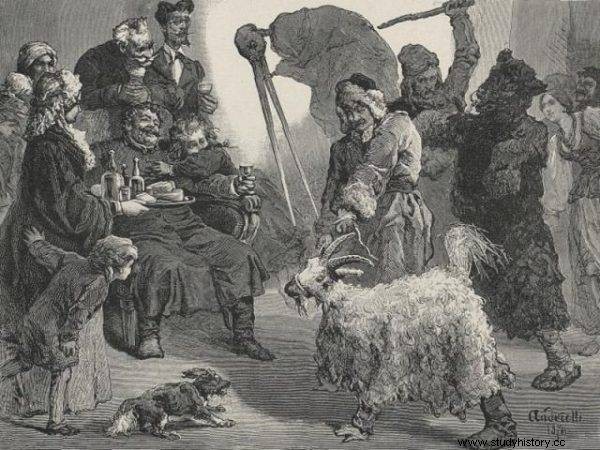
Shrovetide in the inn
What was happening then in old Polish manors, cities and inns? Above all else, you were eating - lots and lots of fat. After all, it was supposed to be a goodbye to meat for the entire 40 days Lent. In the seventeenth century, a popular song was popular in noble manors that for Shrovetide " [...] you do not want cabbage; they prefer roe deer, deer and bison roasts ”. It was indeed so. Tables - of course at the wealthy nobility and magnates - were full of all kinds of meat, mainly venison. For this occasion organized balls, sleigh rides, costumed parades and dancing until the morning . The echoes of those games remained in the words of the song: "One more mazurka today, although the morning is dawning." In Old Polish times, there were also dances of a polonaise, a mill, a hajduk, a candle dance, a German cenar and a French gallard.
Mask makes equal
In the 18th century, masked balls became popular in Polish cities. This custom came to Poland from Italy. The so-called redoubt balls that anyone could enter, regardless of their social position. The condition was to have a ticket and a mask, which gave anonymity and made the king and the pug even for this brief moment equal. Król - because at balls in the house at ul. On Piekarska 105, where the first Warsaw masquerades took place, Augustus III the Saxon himself appeared.
During the carnival, masquerades were held even 4-5 times a week. Their popularity was so great that over time the games were transferred to magnate palaces in Warsaw - Przebendowski, Jabłonowski or Radziwiłłów. In redoubts, people would dance, watch each other, guess the identity of guests wearing masks, flirt, romance, play cards, gossip.
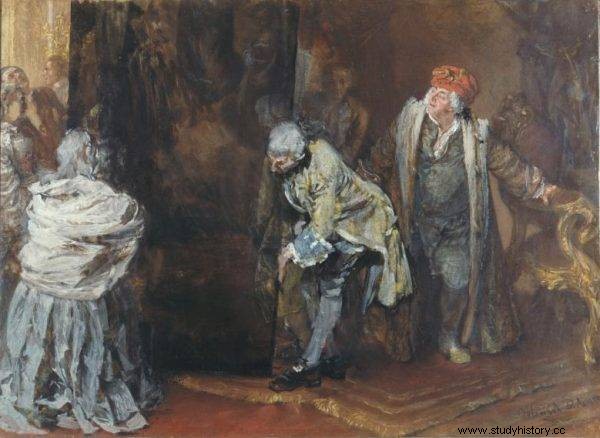
In the house at ul. On Piekarska 105, where the first Warsaw masquerades took place, Augustus III the Saxon himself appeared.
Apart from the mask, the so-called dominoes - large hooded coats that kept guests secret. Those who did not want to be recognized, such as spouses checking their wives' faithfulness, could not take off their masks all evening. Covering the face allowed the common commoner to talk to the king, magnate or official as equals. Such a meeting, impossible in normal life, took place somewhat outside the protocol, it did not have any consequences for both parties.
Rooms of bliss
The time of the carnival before the period of severe penance allowed us to step out of the corset of everyday social roles, at least for a moment. In this way, a common lover or a simple craftsman could kidnap a high-born lady to dance, and a shoemaker from the area to get drunk with aristocrats. Of course, the difference in social statuses was felt - for example by manners and language. But as long as the stranger's face was covered with a mask, such points were only conjectures.
The mask, hiding the true identity, encouraged the delinquent to be more courageous and favored the mating of couples, even if it was illegal and socially stigmatized. In the Saxon and Augustów times, in the palaces where redoubts took place, there were special rooms for private meetings . The keys could be obtained from the staff at the entrance. Couples wishing for intimacy also went to the carriages, which then drove lovers to distant places in the capital. Jędrzej Kitowicz, the author of "Description of the customs during the reign of Augustus III", recalled disapprovingly:" such devastated lovers would never return to the redoubt, entering among the guests among whom the husband of a wife or the mother of a daughter had been searching in vain during that time."
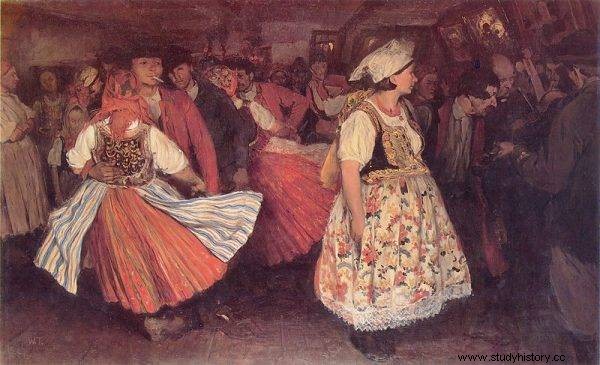
The time of the carnival before the period of severe penance allowed me to leave the corsets of everyday social roles for a while.
In the times of Stanisław August Poniatowski, redoubts took place not only in the capital, but also in other cities - in Kraków or Poznań. The egalitarian nature of the masked games gave the poorer nobility and the families of the community a chance to raise their status. It was enough during this period to “sell” my daughter well . That is why - as in a fairy tale about Cinderella - matrons and aunts dressed up their charges at the release so that they delighted wealthy, well-to-do aristocrats. No money was spared on bows, decorations and beautiful costumes. During the carnival, traveling merchants who offered such goods could count on decent earnings.
The sleigh ride is tearing from the hoof
Historian Jędrzej Kitowicz also described another landowner, typically Polish Shrovetide custom, that is sleigh rides, and therefore traveling feasts and drunkenness, which, according to chroniclers, lasted until the pantries of subsequent hosts were emptied. Usually, the landowners' neighbors visited each other, often without announcement, to feast "to the limit", and then get on a sleigh with a cheerful, highly tipsy company and enjoy the visit of the next neighbor.
The sleigh ride, i.e. the ceremonial sleigh ride with horses harnessed to it, was the most spectacular element of the carnival visits. At that time, the landed gentry hired bands and processions of fancy dress, which, to the accompaniment of cheerful music, and in the evenings by torches, accompanied the party people. The wealthier ones employed whole bands, which played while riding on separate sleds, and everything was supervised by a harlequin - the chieftain.
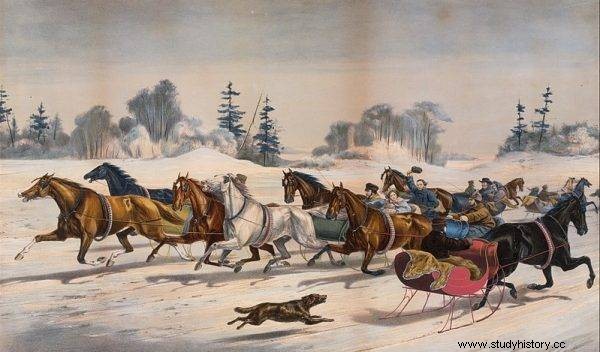
The sleigh ride traveled from manor house to manor house, and was greeted with food and drink in each of them.
Such a sleigh ride traveled from manor house to manor house, and each one was greeted with food and drink. Unfortunately - chroniclers noted with pain that more than once a well-fledged society, equipped with sabers, lost control over itself and over the fun. So it happened that a person encountered by chance, who did not like traveling party people, could end up miserably. Blood was spilled during sleigh rides and processions.
A murderous Christmas carol
Colorful parades of costumers and carollers were popular especially in the villages. In the last days of the carnival they were dressed as animals (horse, aurochs, goats, storks), allegorical (devil or death) or human (e.g. a Jew, a Gypsy, an Armenian, but also a priest or a doctor) . The procession was opened by Prince Zapust - a straw puppet. Accompanied by music from folk instruments - bagpipes, lyre mazanki - the procession wandered from house to house, demanding refreshments. Girls at the release and bachelors were wished, in coarse words, a quick marriage or a marriage, and even jokingly punished for their maidenhood, e.g. by mock flogging.
There were also times during the Christmas carols. that the guests turned out to be too persistent and their expectations too persistent. If they were tipsy, the merry retinue could turn into a bunch of attackers. Jan Stanisław Bystroń, author of "The History of Customs in Old Poland", recalled that crimes during the New Year's games were not uncommon and it is already mentioned in medieval records - for example the diocesan statute issued in Krakow in 1408, which states that when the laity go after Christmas carols, there are thefts and even murders " as a result of devilish temptation and the abuse of bad people."
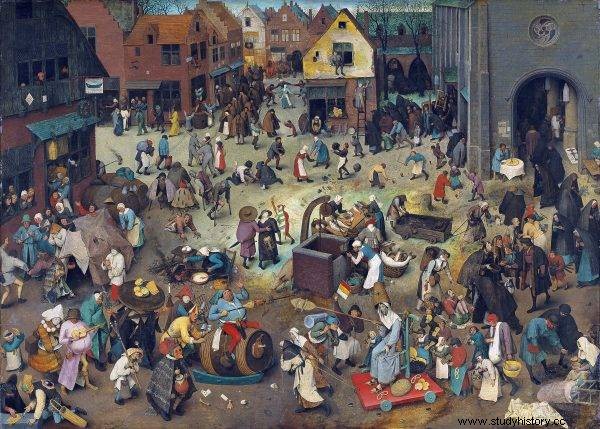
The intensity of centuries-old Shrovetide games may surprise modern people.
Lent
The intensity of centuries-old Shrovetide games may surprise modern people. Today, it is true that the carnival period is still formally spoken of and it is distinguished in the calendars. We mention Shrovetide and Śledzik, a time of indulging in eating, drinking and playing just before the period of fasting, and it is a custom directly derived from carnival games. However, this tradition is slowly becoming dead. This is because in today's secularized society there is no particular playtime. These can last at any time of the year, and Lent itself does not play such a role as it did several dozen, let alone hundreds of years ago.
In Old Polish times, during the preparation for the Resurrection of the Lord , meat, animal fats, and sometimes honey, sugar or dairy products disappeared from tables in Polish homes for 40 days . Instead, cereal dishes, herring and other simple vegetarian dishes were consumed in greater quantities. Lent was also a time of refraining from boisterous games, music and dancing. They also abstained from alcohol and tobacco. Instruments, intensively used during Shrovetide, were hidden in wardrobes, as were festive costumes, colorful skirts and scarves. Modest clothes were worn in muted colors. They met in silence, praying together or singing religious songs.
The period of reflection and self-limitation ended with Holy Week - just before the Lord's Resurrection, during which fatty dishes and meat appeared on the tables, and family and social gatherings were again accompanied by music, dancing and cheerful singing.
Bibliography:
- Jan Stanisław Bystroń, The history of customs in old Poland , Warsaw 1993.
- Zygmunt Gloger, The Polish Year in Life, Tradition and Songs , Warsaw 1900.
- Jędrzej Kitowicz, Description of customs during the reign of Augustus III , Wrocław 1951.
- Radosław Lolo, Old Polish Shrovetide , Museum of King Jan III's Palace at Wilanów (access:8/02/2022).
- Agnieszka Zarychta-Wójcicka, Redoubts - carnival balls of all states , Museum of the Radom Countryside (accessed on 2/8/2022).
